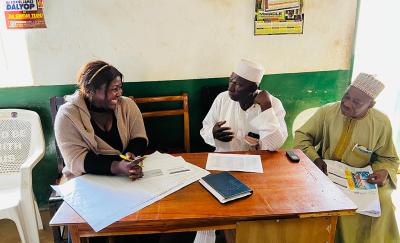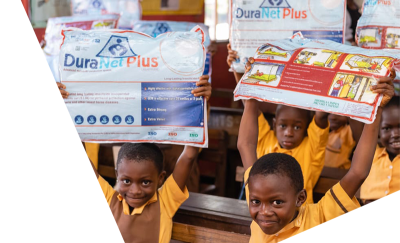Community Influencers Help Improve Tuberculosis Screening


The stigma about tuberculosis (TB) is traumatizing. So, people in the Democratic Republic of Congo with the infectious disease hide their condition, making it harder to identify and treat the ailment and reduce the high transmission rate. In 2021, the Provincial Health Division of Kasaï-Oriental alone found 20,913 active cases.
Enter the Programme National de Lutte contre la Tuberculose (PNLT, National Tuberculosis Control Program), and the Abt-led USAID Integrated Health Program (IHP). Two years ago, the PNLT and USAID IHP started to train community influencers in Kasia-Oriental’s capital, Mbuji-Mayi: pastors, teachers, leaders of non-governmental organizations, women and youth groups, and traditional leaders. The training included awareness raising, communications skills, and messaging. The goal: to prepare the influencers to play an increasingly critical role in the fight against TB. And that effort has paid off with substantial increases in detection and treatment.
A major reason is that these groups have their communities’ respect and often serve as trusted advisors. Studies have shown that trust is the best indicator of successful health outcomes in tackling infectious diseases, and localization approaches take advantage of this trust. After all, local influencers interact with community members regularly. That gives them the chance to change minds and behavior.
In collaboration with PNLT, USAID IHP began implementing the approach of using influencers to go door-to-door to identify people who have symptoms of TB, such as a cough. Then they used their strong community relationships to encourage anyone with symptoms to seek a diagnosis and treatment from a medical professional. For those who opted for treatment, influencers continued to play a key role in urging adherence to treatment regimens to prevent antibiotic resistance.


This past year, the PNLT and USAID IHP celebrated World Tuberculosis Day in March by hosting a community-wide event to share key messages about identifying and treating TB. They invited political, administrative, and health authorities to participate and held six meetings with health zone management teams, provincial health district staff, and members of the community. They mobilized community donations, which they used to print and distribute informative posters on TB symptoms and purchase megaphones to make public service announcements on TB detection and treatment.
"I am very happy that thanks to influencers, we were able to organize two screening campaigns and celebrate World Tuberculosis Day,” said Dr. Marcel Kazadi, Provincial Coordinating Physician for Leprosy and Tuberculosis. “These commendable efforts have made it possible to mobilize and sensitize the population, and to direct people to get screened for tuberculosis.”
After the celebration, influencers held two active TB screening campaigns in the health zones of Lukelenge and Bipemba. They visited 1,660 households, reached 6,022 people (including 3,652 women), and encouraged everyone with symptoms to get tested for TB. Ultimately, they identified 82 cases of bacteriologically confirmed pulmonary TB—including 16 cases of multi-drug-resistant (MDR) TB. Healthcare providers immediately put everyone with an active case of TB on treatment.


To date, we have increased the number of patients in our catchment areas initiating standard (first line) TB treatment from 61,974 to 101,857 and at the end of 2022, we saw the highest quarterly rates of treatment yet. Second-line treatment (for MDR TB) is growing even faster, jumping from 194 cases in the project's first year to 583 in the fourth year. And case detection of MDR TB has more than doubled in the last two years, indicating better testing.
Thanks to the training, “we were able to unite our efforts and use our influence to organize mini-campaigns and celebrate World Tuberculosis Day,“ said Mrs. Anny Masengu, a community influencer. “Most importantly, we can save the lives of many people by screening them for TB and putting them on treatment.”
The success of the PNLT-USAID IHP collaboration is having a ripple effect. USAID IHP has replicated the approach and campaigns in other health areas, health zones, and provinces. Influencers now raise awareness not only about TB but also about other topics like malaria, COVID-19, and use of public health services. Trust in influencers, it turns out, can have a remarkable impact in efforts to improve health outcomes.
Read More

Pathways to UHC: Nigeria’s State and Local Approaches to Financing Integrated HIV Services and Primary Health Care
Nigeria’s state and local government-driven approaches to integrated primary health care are transforming financial protection and access for vulnerable populations, setting a replicable model for sustainable universal health coverage.

Building Climate Resilience Through Private Sector Partnerships
The Partnership for Climate Action, led by USAID CACCI, helps the private sector contribute to climate resilience through investment and innovation.

Health Systems Research (HSR) 2024
Abt Global is exhibiting and presenting at Health Systems Research (HSR) in Nagasaki, Japan in November 2024.

The 2024 Annual Meeting of the American Society of Tropical Medicine & Hygiene (ASTMH)
Abt Global is presenting and exhibiting at the 2024 Annual Meeting of the American Society of Tropical Medicine & Hygiene (ASTMH).